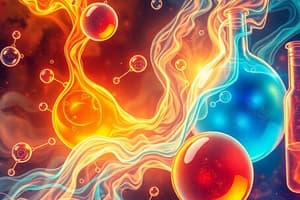Podcast
Questions and Answers
What is one of the key aspects of inorganic chemistry?
What is one of the key aspects of inorganic chemistry?
- Polymer synthesis
- Organic compound reactions
- Pharmaceutical development
- Crystallography (correct)
Which branch of chemistry explores compounds that do not contain carbon atoms?
Which branch of chemistry explores compounds that do not contain carbon atoms?
- Organic chemistry
- Biochemistry
- Inorganic chemistry (correct)
- Analytical chemistry
What does catalysis involve in chemistry?
What does catalysis involve in chemistry?
- Speeding up chemical reactions without being consumed (correct)
- Slowing down chemical reactions
- Consuming substances in a reaction
- Creating new chemical elements
Which of the following is NOT an application of inorganic chemistry?
Which of the following is NOT an application of inorganic chemistry?
What is coordination chemistry primarily concerned with?
What is coordination chemistry primarily concerned with?
How do organic and inorganic chemistry relate to each other?
How do organic and inorganic chemistry relate to each other?
What is the primary focus of organic chemistry?
What is the primary focus of organic chemistry?
Why is organic chemistry crucial in the scientific realm?
Why is organic chemistry crucial in the scientific realm?
Which aspect of organic chemistry involves the study of the three-dimensional arrangement of atoms?
Which aspect of organic chemistry involves the study of the three-dimensional arrangement of atoms?
What does reactivity in organic chemistry refer to?
What does reactivity in organic chemistry refer to?
What is a key feature of organic chemistry mechanisms?
What is a key feature of organic chemistry mechanisms?
'Organic' compounds are molecules that primarily consist of which element?
'Organic' compounds are molecules that primarily consist of which element?
Flashcards are hidden until you start studying
Study Notes
Discovering the Building Blocks of Matter: Organic and Inorganic Chemistry
In the vast realm of chemistry, we find two distinct yet interconnected branches that help us comprehend the world around us. Organic chemistry and inorganic chemistry are the two fundamental pillars of this scientific discipline, each with its own unique features and applications.
Organic Chemistry
Organic chemistry, as the name suggests, primarily focuses on the study of organic compounds—molecules containing carbon atoms, bonded with hydrogen, oxygen, nitrogen, and other elements. These compounds are prevalent in living organisms, such as carbohydrates, proteins, and fats. Organic chemistry is crucial due to its direct connection to biology and the role of organic compounds in the processes of life.
Some of the key aspects of organic chemistry include:
- Synthesis: The production of new organic molecules through chemical reactions, often involving complex procedures and techniques.
- Reactivity: The study of how organic molecules react with each other, as well as with other substances, and the factors that govern these reactions.
- Stereochemistry: The study of the three-dimensional arrangement of atoms and the consequences of this arrangement on the properties of organic molecules.
- Mechanisms: The study of the step-by-step processes by which chemical reactions occur, including the role of intermediates and transition states.
Organic chemistry has many real-world applications, such as pharmaceuticals, agriculture, and the production of polymers—from plastics to synthetic fibers.
Inorganic Chemistry
Inorganic chemistry, on the other hand, explores the properties and behavior of non-organic compounds—molecules that do not contain carbon atoms but may include elements such as hydrogen, nitrogen, oxygen, and metals. Inorganic chemistry covers a wide range of substances and phenomena, including catalysis, materials science, and electrochemistry.
Some of the key aspects of inorganic chemistry include:
- Crystallography: The study of the arrangement of atoms in crystals, and the properties of materials that arise from this arrangement.
- Catalysis: The use of substances to speed up chemical reactions without being consumed in the process.
- Electrochemistry: The study of the relationship between electricity and chemical reactions, and the use of electricity to drive chemical reactions.
- Coordination chemistry: The study of the bonding between central metal atoms and ligands, which are electron-donating molecules or ions.
Inorganic chemistry has many practical applications, including the production of materials such as semiconductors, batteries, and catalysts, as well as in environmental remediation efforts and energy production.
Interconnectedness and Overlap
Despite their differences, organic and inorganic chemistry are not entirely separate disciplines. There is considerable overlap between the two, as many compounds contain both organic and inorganic components. For example, transition metal complexes, which are particularly important in materials science and catalysis, often contain both organic and inorganic ligands.
In conclusion, organic chemistry and inorganic chemistry are two vital branches of chemistry that allow us to understand the fundamental building blocks of matter. Each offers a unique perspective on the natural world and has numerous applications in various fields. By studying these two disciplines, we can continue to uncover the secrets of the universe and improve our quality of life through new technologies and insights.
Studying That Suits You
Use AI to generate personalized quizzes and flashcards to suit your learning preferences.




